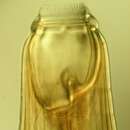en
names in breadcrumbs


Nematodes within the Secernentea have phasmids, which are unicellular glands. Phasmids likely function as chemoreceptors. Females may produce pheromones to attract males.
Nematodes in general have papillae, setae and amphids as the main sense organs. Setae detect motion (mechanoreceptors), while amphids detect chemicals (chemoreceptors).
Communication Channels: tactile ; chemical
Other Communication Modes: pheromones
Perception Channels: tactile ; chemical
The life cycle of S. vulgaris involves five juvenile stages and its equine host. Eggs are found in its host feces, where they hatch and the juveniles feed on the feces through the third larval stage. At this point, they crawl onto vegetation the equines feed on, where they are ingested by the host. Once in the small intestine, the third-stage juvenile penetrates through the intestinal wall and molts into its fourth larval stage. The larvae penetrate the surrounding arteries and make their way to the mesenteric arteries, where they develop into the fifth larval stage, immature adults. The immature adults make their way back to the intestines, where they encapsulate themselves and develop into adults. The adults hatch from the capsules and mate, producing eggs which are passed out in the feces.
Strongylus vulgaris has at times been a very common parasite in horses; it was estimated that it was present in 90% to 100% of horses in the U.S. The inflammation caused by the strongyle travelling throughout the arteries and intestines can cause blood clots to form. The clots can block oxygen passage to the intestines, causing parts of them to die. Ultimately, besides causing abdominal pain (colic) in equines, the complications from S. vulgaris infestation can lead to death.
S. vulgaris is no longer considered as much of a threat to horses, because it can be controlled by drugs such as benzimidazoles, ivermectin, and moxidectin, which kill both larvae and adult stages of the worm.
Negative Impacts: causes or carries domestic animal disease
Strongylus vulgaris is parasitic on horses.
Ecosystem Impact: parasite
Species Used as Host:
Through the first three larval stages of development S. vulgaris feeds upon the feces of its parent's host. The later larval stages are found in the circulatory system of equines, feeding on blood and tissue as it makes its way through different areas of the body. The adults are primarily found in the intestine and associated organs, where their feeding can cause major damage to the gastrointestinal organs.
Animal Foods: blood; body fluids
Other Foods: dung; microbes
Primary Diet: carnivore (Eats body fluids); coprophage
This parasite can be found worldwide; its dispersal is dependent on where its hosts (equines) are found.
Biogeographic Regions: nearctic ; palearctic ; oriental ; ethiopian ; neotropical ; australian
Other Geographic Terms: cosmopolitan
Strongylus vulgaris is found primarily in grasslands and pastures. They are essentially located where equine populations are concentrated.
Habitat Regions: temperate ; tropical ; terrestrial
Terrestrial Biomes: tundra ; taiga ; desert or dune ; savanna or grassland ; chaparral ; forest ; rainforest ; scrub forest ; mountains
Wetlands: marsh ; swamp
Other Habitat Features: urban ; suburban ; agricultural
These worms are cylindrical, dark red in color, with male adults approximately 2.5 to 4 cm in length, while females range from 4 to 6 cm. There are five larval stages before adulthood is reached. The buccal capsule, which adults use to feed, is relatively large and heavily sclerotized, with two lobed teeth. The anterior region is dorsally curved, giving the appearance characteristic of hookworms.
The cuticle has three or more main outer layers made of collagen and other compounds. The outer layers are non-cellular and are secreted by the epidermis. The cuticle layer protects the nematodes so they can invade the digestive tracts of animals.
Nematodes have longitudinal muscles along the body wall. The muscles are obliquely arranged in bands. Dorsal, ventral and longitudinal nerve cords are connected to the main body of the muscle.
Range length: 2.5 to 6 cm.
Other Physical Features: ectothermic ; heterothermic ; bilateral symmetry
Sexual Dimorphism: female larger; sexes shaped differently
These parasites are probably not preyed on directly, but are likely ingested by various animals. Larval mortality is high as most of the parasites do not reach appropriate hosts.
Females may produce a phermomone to attract males. The male coils around a female with his curved area over the female genital pore. The gubernaculum, made of cuticle tissue, guides spicules which extend through the cloaca and anus. Males use spicules to hold the female during copulation. Nematode sperm are amoeboid-like and lack flagella.
Key Reproductive Features: sexual ; fertilization (Internal ); oviparous
Parental Investment: pre-fertilization (Provisioning)